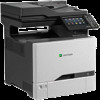Lexmark XC4143 Users Guide PDF - Page 142
Statement of Volatility, Disposing of a printer hard disk
 |
View all Lexmark XC4143 manuals
Add to My Manuals
Save this manual to your list of manuals |
Page 142 highlights
Securing the printer 142 Statement of Volatility Type of memory Description Volatile memory The printer uses standard random access memory (RAM) to buffer temporarily user data during simple print and copy jobs. Non-volatile memory The printer may use two forms of non-volatile memory: EEPROM and NAND (flash memory). Both types are used to store the operating system, printer settings, network information, scanner and bookmark settings, and embedded solutions. Hard disk memory Some printers may have a hard disk drive installed. The printer hard disk is designed for printer-specific functionality. The hard disk lets the printer retain buffered user data from complex print jobs, form data, and font data. Erase the content of any installed printer memory in the following circumstances: • The printer is decommissioned. • The printer hard disk is replaced. • The printer is moved to a different department or location. • The printer is serviced by someone from outside your organization. • The printer is removed from your premises for service. • The printer is sold to another organization. Disposing of a printer hard disk • Degaussing-Flushes the hard disk with a magnetic field that erases stored data • Crushing-Physically compresses the hard disk to break component parts and render them unreadable • Milling-Physically shreds the hard disk into small metal bits Note: To guarantee that all data are completely erased, destroy physically each hard disk where data is stored.















